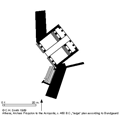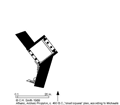| Context: | Athens |
| Type: | Gate |
| Summary: | Gate-building with a stepped forecourt; western end of the Acropolis, approximately the same location as the later Propylaia of Mnesikles. |
| Date: | ca. 600 BC - 437 BC |
| Region: | Attica |
| Period: | Archaic |
Plan:
According to Dinsmoor, both east and west ends had facades of 4 columns in antis. Behind the east columns, 4 piers in antis created a narrow aisle between the facade and the piers. The middle 2 piers were more widely spaced to allow for double doors, and the middle 2 columns of both facades were spaced to match. Inside the west end was a large rectangular area, with 2 rows of 3 columns flanking a ramped approach. Outside the west end, on either side of the ramp, 2 steps led up to the entrance; at the interior end of the ramp, 3 more steps rose to the aisle between the piers and the eastern facade. Other interpretations of the plan include: Dörpfeld 1885, Michaelis 1901, Choisy 1899, Weller 1904, Stevens 1946 and Bundgaard 1957.
Dörpfeld: small square plan with no columns.
Michaelis: small square plan with 2 columns in antis at both ends.
Choisy: wide plan, rectangular, wide openings at both east and west ends, no columns.
Weller: narrow plan, rectangular, with narrow east and west ends, 2 columns in antis at both east and west ends.
Stevens: wide plan, 4 columns in antis at both ends, 4 piers in antis and colonnaded approach, much like Dinsmoor's plan.
Bundgaard: large plan, 4 columns in antis at both ends, 4 piers in antis, no colonnaded approach, again much like Dinsmoor's.
Dörpfeld: small square plan with no columns.
Michaelis: small square plan with 2 columns in antis at both ends.
Choisy: wide plan, rectangular, wide openings at both east and west ends, no columns.
Weller: narrow plan, rectangular, with narrow east and west ends, 2 columns in antis at both east and west ends.
Stevens: wide plan, 4 columns in antis at both ends, 4 piers in antis and colonnaded approach, much like Dinsmoor's plan.
Bundgaard: large plan, 4 columns in antis at both ends, 4 piers in antis, no colonnaded approach, again much like Dinsmoor's.<
History:
According to Dinsmoor, there were several phases in the construction of the Archaic Propylon. First, in the pre-Propylon period ca. 489 B.C., there was an L or odd Z shaped, stepped forecourt. Between 489 B.C. and 480/79 B.C. (year of the Persian sack) began construction of the walls, front steps and stylobate. Also portions of the Pelasgian Wall were removed and the bedrock was hewn into horizontal planes. By 480 B.C., antae near the ends of the facades and some columns had been erected. finally, there was a rebuilding after the Persian invasion, probably under Kimon in the 460's B.C.
Other Bibliography:
See Also:





